March 2018
One of the great pleasures of travel is coming across something unexpected that brings a frisson of pleasure at the discovery. The usual Western approach, of course, is to plan one’s delights carefully so they occur in measured progression over the allotted period of travel. When you’re spending a king’s ransom on a trip, such methods are perfectly justifiable. It would hardly do to leave things to chance because chance is notoriously disinterested in delivering good value for money.

Church in San Joaquin, Iloilo Province
But there’s something to be said for a serendipitous approach to travel, which loses the discomfiting prospect of risk if the travel is local. After jetting about the islands of the Philippines for three months last year, I decided this year to stick closer to home (Iloilo on Panay Island) and enjoy all the variety available within easy reach on my adopted island and its close neighbors, Guimaras and Negros. I chose Panay as my base in part because of the visible history in this area. I’m speaking of Spanish colonial history, of course; of the pre-Spanish native Ati and Malay cultures nothing tangible remains. Stories still circulate about Datus from Borneo landing near San Joaquin and setting up kingdoms through peaceful negotiation rather than force of arms, and native Ati groups still live in the mountain range on the island. But the historic traces of those groups are no more. What remains are the stones put one on top of another in the so-called “Earthquake Baroque” of the historic churches of Panay, the construction of which was spurred by Augustinian friars active well after the Spanish adventurers who gained a toehold in the Islands in the 16th century. These remarkable churches dot the countryside around Iloilo in what seems to me great profusion: Tigbauan, Guimbal with its charming turret and its gaze out over the sea, Miagao (now a Unesco World Heritage Site) and San Joaquin, where the Malay datus from Borneo first landed. I feel a blog post or two brewing as I think about Guimbal and Miagao — those churches were instrumental in my decision to settle on Panay Island, because nowhere else in Visayas is there anything like them in quantity or quality.
I’d researched the historic churches of Panay before coming to Iloilo for the first time, so my visits to Miagao and Guimbal definitely fell into the “planned” category. I had one week to spend during my first trip here and wanted to cram in as many sights as possible, just as a responsible and competent western tourist should. The foresight paid off, of course (as it usually does), and I got exactly what I was after.
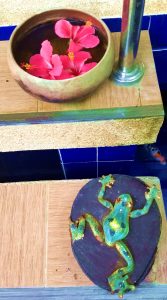
Entrance Steps, Assemblage Point
Since becoming a resident here in Iloilo, however, the more off-the-cuff local travel phase has begun and yields very different but equally satisfying results. One surprise I discovered in the local area is Assemblage Point Resort, to the west of San Joaquin on the southern coast of Panay very near the border between Iloilo and Antique Provinces. What’s most surprising about the place is that it’s like a warp in the space-time continuum. You pull into the parking area, get out of the car, and all of a sudden you’re in a little piece of Thailand.
The resort is the creation of the Filipino couple who own the property. The wife decided to decorate things in the Thai manner and has done a fine job of it. Walking about the place, I felt the urge to say “Sawadee khap” as I met staff coming and going about their appointed rounds. I’ve spent months at a time in Thailand, in Chiang Mai to be precise, so I know whereof I speak. The decor exudes the Thai atmosphere of elegance and tranquility. Those two qualities are the main hallmarks of Thai interiors as I know them. I can readily think of other qualities characteristic of Thai interior and exterior spaces. The Thais have an amazing aesthetic sense that enables them to place things in a space so that they appear natural but at the same time well thought out. There’s never a sense of clutter, the objects in the design have space to breathe and be themselves without imposing their presence on other elements in an untoward jumble. You’ll inevitably notice small decorative details that give a sense simultaneously of elegance and coziness — for example, a bowl of floating hibiscus flowers on the entrance steps and an amusing plaque of a frog looking ready to climb into the bowl. At every turn the eye finds something interesting and pleasing to engage it, yet the overall impression the space conveys is of order and calm.
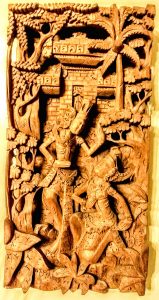
Woodcarving, Assemblage Point

Decorative Panel, Assemblage Point
Rich detail in some of the objects invites long gazes to take in the intricacies of design and execution. These objects are placed in such a way that the eye catches them in passing. They don’t stand front and center in a position that commands your attention whether you will or no. That design slight of hand always leaves me with the feeling not of having been tricked, but rather of stumbling into a magical place where the visual riches are so abundant that walking about becomes a kind of treasure hunt. What lovely thing might appear round the next corner? Let’s have a look, shall we? In other words, the design approach is founded on the elegance of understatement, although the objects placed understatedly are themselves often stunning and worthy of lengthy and serious attention. I think this method underpins how Thai decorative schemes achieve an apparently self-contradictory state of great visual interest and pervading calm. I always feel brought into a better state of myself in such an environment. You have to live up to the beauty around you. To do otherwise would contravene the tone of everything and show you to be a boor of the first order. And we certainly don’t want to lose face, now, do we …
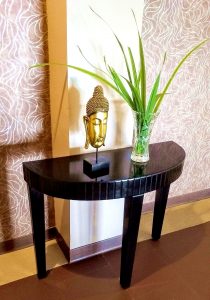
Thai Decor, Assemblage Point
The resort is not huge, which is an advantage, not a disadvantage, in my opinion. The last thing I want when visiting such a resort is hordes of kids splashing about in the pool or packs of teenagers congregating in the garden staring at their mobile phones and playing God knows what music without the headset on. The weekend I spent at Assemblage Point was quiet and our group, myself and two friends, essentially had the run of the place. My friends, considerably younger than I and ready to be in the water, found the beach adequate. The southern coast of Panay Island is not a place for stunning beaches, to be honest. The rock here is volcanic and the raw material for sand is basalt, not coral, which is no recipe for a white beach of standard tropical paradise issue. The sand is black — what little of it there is. Unless you’re aware of the geology before you arrive, you might be disappointed when you look out over the coastline and find yourself reminded more of Maine than of Bora Bora. So give over the search for gleaming expanses of white sand. Adopt the notion that an aesthetically successful coastline can also be sculptural. That’s the ticket. 🙂
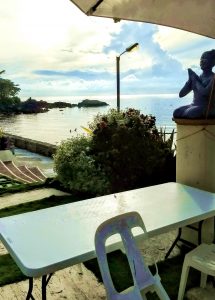
View from Pool, Assemblage Point
I’m not a water baby by any stretch of the imagination, so I wasn’t in the least bothered by the absence of white sandy beach. My two friends, who take every opportunity to be in the water that comes their way, spent much more time in the pool than they did in the ocean — and a fine pool it is, perhaps partly in compensation for the rubbish beaches Nature has provided resort-goers in this part of Panay. The only drawback to the pool area in my opinion was the pop music blaring away. But hey, it’s the Philippines, it’s bound to happen. I would have objected to the auditory element even if Mozart had issued forth from the speakers instead of Rihanna. When I sit of an evening in a chaise lounge by a pool with my Kindle, I require no vocal accompaniment. Churlish of me, I realize, but there it is. It just served to remind me that this piece of Thailand is indeed in the Philippines, where pop music in public spaces is as common as the very air we breathe.
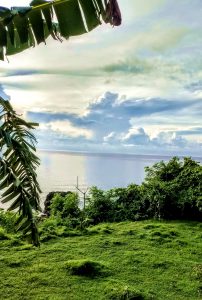
Landscape near Assemblage Point
The morning of the next day saw me setting out for a bit of a stomp in the vicinity. The surroundings are bucolic, of course, since you’re out in the middle of nowhere. Just my style. I walked down the coastal road not more than a quarter mile before lovely vistas of fields and ocean opened before me. As usual, my attention was arrested by the wildflowers along the road. Wildflowers here always leave me scratching my head in wonder — is that really wild or did it just escape from someone’s garden? Can so large and showy a flower really be wild? Yes, Bridget, it is wild, whether or not your expat eyes accustomed to the niggardly inflorescences of the Bitter North can wrap themselves around that fact. Relax, let yourself go, we’re all going to heaven and Vandyck is of the company. There’s plenty more where that came from.
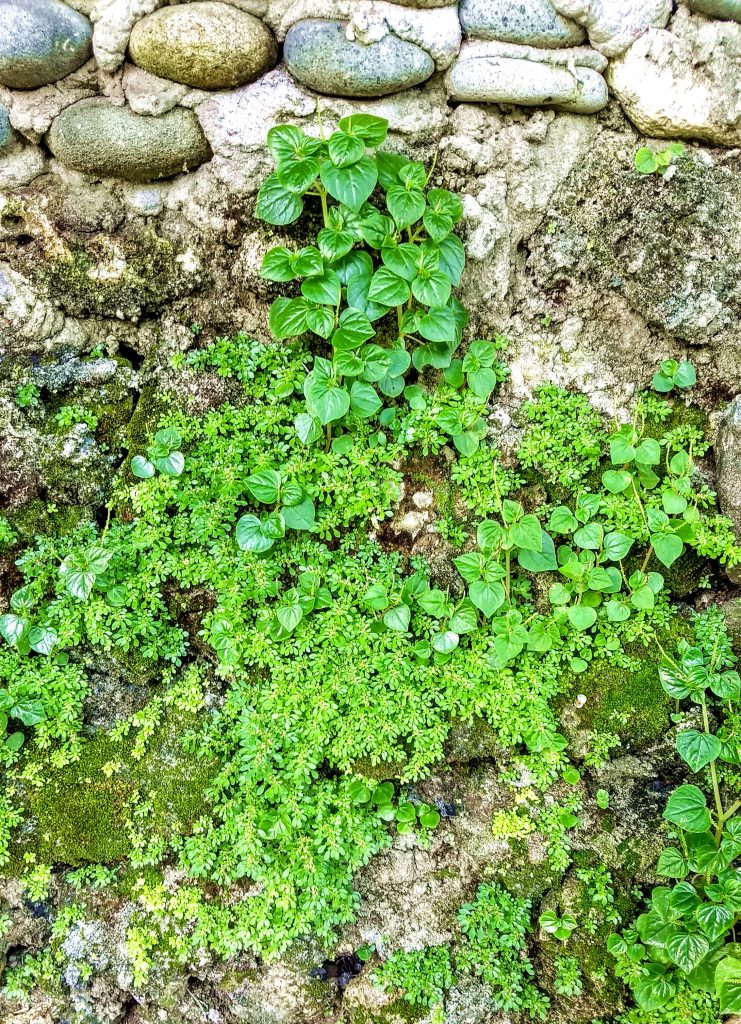
Retaining Wall, Assemblage Point
We had arrived at the resort the day before at a relatively late hour, so when I returned from my ramblings the next morning I inspected the front grounds for the first time. I saw a very nicely done retaining wall in the parking area built with stones rather than cinder blocks or concrete, and growing on the stones was a profusion of lovely greenery that left me scratching my head in the same way the wildflowers did. If a gardener had set about creating a foliage group on the face of the rock wall I could understand it and give an energetic thumbs up for a brilliant job done. But it’s a retaining wall in a parking lot, not a rock garden, so it seems most likely that the only hand to which design and execution can be ascribed is that of Nature itself. If I had built a rock wall in my own garden and managed to bring off a foliage grouping like that, I’d set myself up as a landscape consultant straightaway and expect to see the money start rolling in like it was shot out of a cannon. But you can’t compete with Mother Nature, of course …
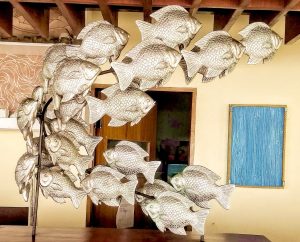
Scultpure, Restaurant, Assemblage Point
Food is an essential element of a resort weekend and the restaurant at Assemblage Point is good. Equally as good as the food, however, is the design of the restaurant space. It lies adjacent to Reception on the main floor and stands open to the sea. Brilliant! While waiting for your food you can stroll over to the railing, look out over the open ocean and let the breeze waft around you. The decoration is minimalist with the exception of a sculpture near the kitchen, an astonishing swirl of fishes curving in an arc that seems ready to shoot off into the distance as you watch. I have no idea if the sculpture is from Thailand or was done by an artist in the Philippines, but whatever the case, it’s absolutely top drawer.
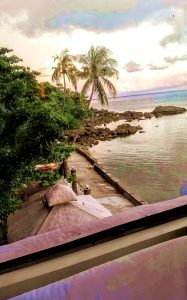
View from bed, Assemblage Point
The room I stayed in was on the second floor and had fantastic views. Have you ever had a fantastic view of a tropical coastline from bed? Well, Bridget, you can have it at Assemblage Point if you get a room on the second floor. Now, this is living … waking up to a view while still tucked under the covers is a very fine way to start the day, and I hazard the guess that you may linger a good while despite the clarion call of that first cup of coffee.
All this handsomeness doesn’t come cheap by Filipino standards, but by American standards you’ll feel you’ve snatched a bargain akin to taking candy from children. I shudder to think what a view like the one I enjoyed would cost in the USA or in Europe. So it’s all good and cheap at twice the price, dive in and abandon second thoughts, you’ll not regret it. And well before your weekend comes to a close, I wager to say you’ll be thinking about the dates for your next visit. That’s what happened to me. How could it be otherwise?
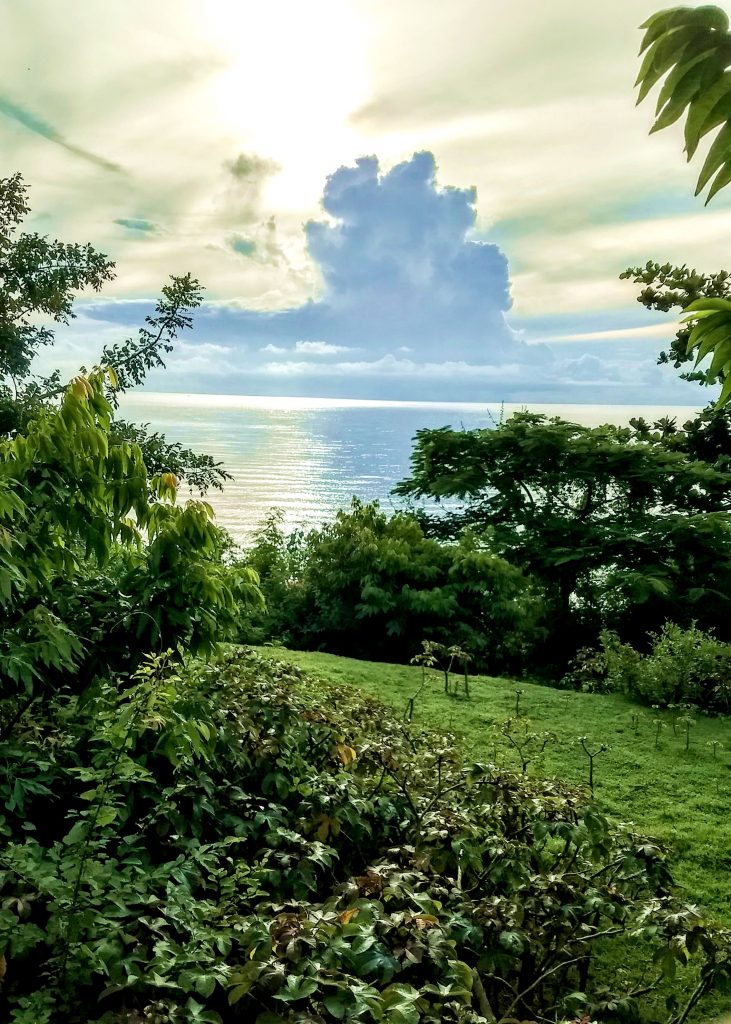
Landscape near Assemblage Point, San Joaquin, Iloilo Province
